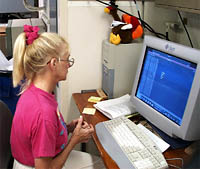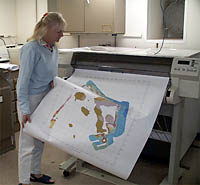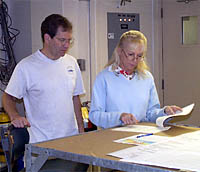|
|
Interviews: Multibeam Trainer and Advisor Uta Peckman What got you started in oceanography? Uta: I’m an outdoor person. I love traveling, snow skiing, or water skiing, being on a train, riding my bike or flying to some far-off place. Being at sea brought that out. I was studying political science at San Diego State University. A friend of mine had a professor at Scripps who needed a lab assistant to help measure the temperature gradients of the Earth. It was intended to be a part-time job, but then my boss had enough confidence in my abilities to send me out to sea. We used a thermometer to measure the heat of the Earth beneath the sediments. Here I was 21, and I traveled from San Diego to Hawaii and then Hawaii to Japan. The whole cruise lasted for two months. The trip went so well, when I returned I was offered a full time job.
Were there other women on board the ship? Uta: That was in 1968, and there were only two other women on the first leg of the cruise from San Diego to Hawaii. On the second leg from Hawaii to Japan I was the only woman. In those days, the crew was mostly older ex-Navy men, who had fought in World War II. They weren’t quite used to the idea of having females on board the ship and some even thought it was bad luck. Question: When did you first start teaching the sonar processing software to others? Uta: When I was 24, I went to Cambridge, England, for three months to teach other scientists how to process the data from a single beam sonar. Back then, we didn’t have multibeam sonar like we have on Revelle. It was flattering to have that kind of responsibility. I lived in a house with other women my age who were going to graduate school, and there I was already working. On weekends, I would take the train into London and go shopping and see plays. Question: What is your goal for this expedition? Uta: The sonar software is always changing and I’ve grown up with the different processing systems. On this cruise I’m writing a tutorial on multibeam analysis so others can understand how to do it. If you know how to process data, you can pay better attention to how sonar data are acquired; what is real information and what is an artifact; and how to make the best images for scientific presentations.
Where have your expeditions taken you? Uta: I’ve been on 30 research cruises in my career. Each year I’m at sea for about one to three months. I fly out to meet the ship and fly home, and at either end I travel to different countries. I have traveled to South Africa, Nairobi, Brazil, Greece, Japan, Chile, Easter Island and throughout Europe. That’s why I don’t have any kids, too busy. I’ve been married now five years on Sept. 28. Question: What did your family think of you becoming a scientist? Uta: My dad was ecstatic I ended up in this field. He had four daughters and no son. I’m the second eldest. He was an aerodynamics scientist and worked on rockets and the space shuttle. He would always say he worked in outer space and I worked in inner space. It’s true we even work on similar measurements. He studied light waves going through the atmosphere and I study sound waves going through the ocean. Question: What was the scariest trip for you? Uta: I was at sea with Gene Pillard and Jack Healy on a trip near Guam when Typhoon Yuri hit. When the waves smashed into the portholes it was like looking at the inside of a washing machine. We had been dodging it for almost a week when we had to abandon the science, close all the portholes and high-tail it to port. It took three days to get back to Guam and in the meantime we were not allowed to go outside. I sat in the Captain’s chair on the Bridge and it was like riding a wild horse. I could see the bow pitch in a wave and the spray was so high it slammed the windows in the Bridge. One night, I was so scared I slept with my life jacket on. Every time we rolled into a wave I wondered if we were going to pop up. One of the waves popped the porthole in the main lab and got water all over the computer equipment at one work-station.
What was your most challenging experience? Uta: When the mulitbeam sonar system technology was brand new, not many people were as familiar with it as I was. On one cruise, I was working with a scientist who was using older maps. We went over an area of seafloor where he expected to see a feature and when I made the new map and handed it to him, he became angry because the feature wasn’t where he expected it. He didn’t think my map was accurate. I went very carefully over all the data one more time and then said if he gave me the latitude and longitude of where he wanted the feature, I could put it there. ’I could move mountains for you if you want me to,’ I said. That made everyone laugh and he realized the old maps might not be as accurate as he thought. Question: What do you think is the most exciting part of your work? Uta: I work on the ocean either on a ship or near the Scripps pier in La Jolla. I have the option to travel. And my passion for learning never quits. I’m around people who are full of ideas. You don’t get rich, but you’re having fun. I can’t even imagine wearing a three-piece suit, high heels and carrying a briefcase or sitting in an office building downtown. At sea when we cross the equator I’m the Queen. I wasn’t always Queen. I had to earn my seat when I crossed the equator in the Indian Ocean. At the end of this trip I will put on a costume that conveys being pulled out of the deep ocean and sit next to King Neptune. Karen Harpp will be my Lady in Waiting and all you pollywogs will have to be punished properly for all the sins you’ve committed on this expedition. |
||||||||||
Mailing List | Feedback | Glossary | For Teachers | About Us | Contact
© 2010 Dive and Discover™. Dive and Discover™ is a registered trademark of
Woods
Hole Oceanographic Institution

 Uta Peckman instructs watchstanders on how to monitor the multibeam system.
Uta Peckman instructs watchstanders on how to monitor the multibeam system.

